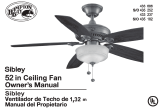5.
Figura 7
Apretar
los tornillos
Interruptor
de reversa
Pasador
de cierre
Posición
de cierre
del pasador
Cables del motor
Ensamblado
de tubo
bajante/bola
Cubierta
Aro de la
cubierta
Cubierta
del collarín
del motor
Pasador
de soporte
Collarín
del motor
Placa de
montaje
en el techo
Gancho
Tornillos de
montaje
(incluidos con
la caja eléctrica)
Cables de
120 voltios
Deslizar
la placa
de montaje
sobre las cabezas
de los tornillos
Caja eléctrica
aprobada
por UL
1. Pasa los cables de suministro de 120 voltios
a través del oricio central de la placa de
montaje del techo como se muestra en la
Figura 7.
2. Instala la placa de montaje del techo en la
caja eléctrica deslizando la placa de montaje
sobre los dos tornillos provistos con la caja
eléctrica (Figura 7). Si es necesario, usa
arandelas niveladoras (no incluidas) entre el
soporte de montaje y la caja eléctrica. Nota
que el lado plano de la placa de montaje está
hacia la caja eléctrica (Figura 7).
3. Ajusta rmemente los dos tornillos de
montaje.
4. Con cuidado alza el ensamblado del ventilador
hasta la placa de montaje. Asegúrate de que
la pestaña sobre la placa de montaje encaje
bien en la ranura de la bola de soporte.
Cómo hacer las
conexiones eléctricas
RECUERDA desconectar la electricidad. Si
crees que no tienes suciente experiencia o
conocimientos en cableado eléctrico, contrata
a un electricista con licencia para que instale el
ventilador.
Sigue estos pasos para conectar el ventilador a
tu circuito doméstico (o sigue las instrucciones
incluidas junto a tu control remoto). Usa las
tuercas de conexión de cables que vienen con
tu ventilador. Asegura los conectores con cinta
CUANDO MONTES EL VENTILADOR EN
UN TECHO INCLINADO, DEBES USAR EL
MÉTODO DE MONTAJE CON TUBO BAJANTE
Y BOLA ESTÁNDAR. ASEGÚRATE DE QUE LAS
RANURAS DEL SOPORTE DE MONTAJE ESTÉN
EN EL LATERAL INFERIOR MEDIANTE EL
DESLIZAMIENTO DE LA PLACA DE MONTAJE
DESDE ARRIBA HACIA ABAJO.
Cómo instalar el ventilador
en la caja eléctrica
aislante. Asegúrate de que no haya cables o
conexiones sueltas (Figura 8).
1. Une los cables verdes del tubo bajante y la
placa de montaje al cable pelado de cobre
(tierra) de la caja eléctrica.
2. Conecta el cable negro (CA EN L) de la unidad
receptora al cable negro de la caja eléctrica.
3. Conecta el cable blanco (CA EN N) de la
unidad receptora al cable blanco de la caja
eléctrica.
4. Conecta el cable blanco (al Motor N) de
la unidad receptora al cable blanco del
ensamblado del ventilador.
5. Conecta el cable negro (al Motor L) de
la unidad receptora al cable negro del
ensamblado del ventilador.
6. Conecta el cable azul (Para la Luz) de la
unidad receptora al cable azul del ventilador.
Después de terminar con las conexiones,
empújalas con cuidado dentro de la caja eléctrica.
Inserta la unidad receptora dentro de la placa de
montaje; asegúrate que el cable de antena negro
quede por encima de la unidad receptora.
LAS FRECUENCIAS DEL RECEPTOR Y TRANS-
MISOR HAN SIDO PRECONFIGURADAS EN LA
FÁBRICA. ANTES DE INSTALAR EL RECEPTOR,
ASEGÚRATE DE QUE LOS INTERRUPTORES
DEL RECEPTOR Y DEL TRANSMISOR ESTÉN
CONFIGURADOS EN LA MISMA FRECUENCIA.
LOS INTERRUPTORES DEL TRANSMISOR ES-
TÁN UBICADOS DENTRO DEL COMPARTIMEN-
TO DE LA BATERÍA.
































